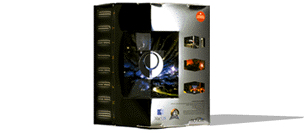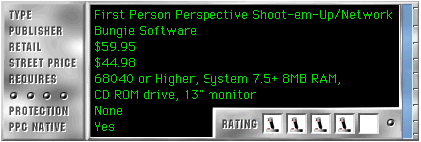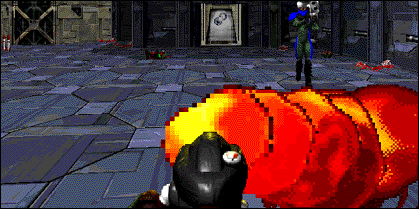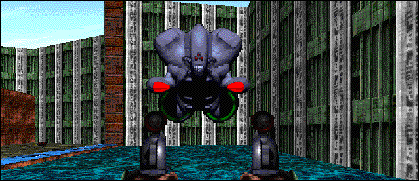


by Jeff Eaton

"Marathon." It's a word that warms many a Mac gamer's heart, bringing back fond memories of grenade-jumping, flipping switches, and encountering Juggernauts for the first time. Soon followed by Marathon II, Bungie Software's hit adventure has become one of the Mac's most popular games. Now, with sequel-itis threatening to rear its ugly head, Bungie has delivered a final installment in the saga that's more than worthy of the Marathon name.
New Game?
First off, officially - Marathon Infinity, technically, is not a new version of the game. One of its key attractions is an excellent new 30-level scenario that caps off the saga. Yes, that's right - everyone's favorite AI's, Durandal and Tycho, are back and battlin' for the universe with you stuck in the middle. The space opera that follows offers some interesting peeks into the mysteries of the first two Marathon games, but what makes the new scenario unique isn't another "Is Durandal really dead?" cliff-hanger. The sheer artistry and complexity of the map design is breathtaking when compared to Marathon I and II. Several of the Infinity maps have more ground to cover than ten of Marathon I's.
Much of this is due to the work of artist and programmer Randy Reddig. A legend in Marathon map-making circles, he helped create the scenario for Bungie. Randy's Magnum Opus, an intricately detailed, sprawling map named "Pfhactory," was left unfinished in mid 1995 when - really! - he hit Marathon II's 512-polygon limit halfway through the creation. Now, in Marathon Infinity, Pfhactory is back, completed. The massive 1000+ polygon space station serves as the setting for several of the game's missions. The "Art" factor of all of the maps is clear, with attractive textures and pleasing architecture. Many maps evoke a strong "feel," reminiscent of playing Marathon I for the first time or watching the movie Aliens in the dark. Ambient ship and wind noises add depth to the environment, and the occasional groaning of machinery can make the unwary 'thonner jump in their seat. There are very few rambling, aimless levels, and all seem designed logically with good "flow." In some cases though, the immense size of the levels can be daunting to the casual player.
Engine Tune-up
Though Infinity isn't SUPPOSED to be an upgrade to Marathon itself, some tweaks to the engine also make the game more flexible. In different areas of the scenario, alliances change and aliens can turn for you or against you, depending on the AI's success at brainwashing them. Conditions, such as gravity, oxygen level and weapon behavior, may change as well. In some cases, you re-visit levels that have already been explored but the layout and atmosphere have changed due to missions accomplished on other levels. The result is a much richer environment and a greater need to be aware of your surroundings. A new combatant - the armored, fusion-pistol packing BOB - enters the fray, and a new weapon is at your disposal. The new flechette machine pistol is a sight to behold, firing with lethal accuracy underwater or in the air, but it chews up ammo in the blink of an eye. Needless to say, there's plenty of carnage to be had and puzzles that tax the brain.

Thirty single-player levels, you say? That's all? Not quite. Bungie has thrown in a full 27 extra levels, mostly multiplayer network maps, to satiate even the most bloodthirsty players. There are quick and brutal arenas for deathmatches, and sprawling complexes for those delicious 8-player stalk-fests. Several "Classic" maps from Marathon I and II are included as well. It's a pleasure to see Mars Needs Women restored so faithfully. Alas, no shotguns adorn the Infinity version of that classic netmap.
For those who want to relive the days of total carnage fist-only games, the "Vidmaster's Challenge" is included. Two maps, arguably the most difficult of Marathon I and II, are included with all save buffers disabled. A third map caps off the challenge with, piling on carnage and nasty ambushes. If you've been itching to blow through "Try Again," and "If I Had a Rocket Launcher," back to back, here's your chance to do it and earn the Vidmaster's honor.
Complaints about Marathon II included the cartoonish look of the graphic textures used to draw the 3D worlds. Many a map designer on the Internet discussed "which textures looked the least bad." Weep no more! All the existing textures have been redone, and an additional one, reminiscent of the original Marathon I look, has been added. The new textures put any other 3D game to shame, with a gritty look that adds a much different "feel" to the game. Even the much-maligned "Alien Textures," which once looked like the results of a late-night binge with Kai's Power Tools, have been transformed by into more subtle and attractive artwork. Even more impressive? The textures are designed to align perfectly with the Marathon II artwork. Although the realism and quality is vastly improved, maps originally designed for Marathon II will need no texture-tweaking to be used with Infinity.
Infinity and Beyond
Network maps, new weapon, new scenario... There's something missing, right? Of course. As implied by its name, Marathon Infinity puts the tools for advancing Marathon into the hands of the players, opening the doors for endless future enhancements. Two editors, Anvil and Forge, offer tools to edit every aspect of the Marathon Universe, creating new graphics, sounds, maps, and multi-part scenarios.

Forge is Bungie's full-featured map editor. It can create maps for Infinity or Marathon II and offers a feature that no other Marathon map editor has - while editing, you can go to "preview" mode and see exactly how the map will look when you play the game, sans aliens and weapons. Walk around and use the convenient palettes to apply textures and lighting modes, drag walls to align textures, and raise floors with a simple click-and-drag. In drawing mode, you can create the basic map shapes, add objects, customize liquids and lighting sets, etc. As someone who used Pfhorte (a freeware map editor for Marathon I and II), I was immediately impressed with the ease of tweaking existing maps or converting old Marathon I maps to use with Infinity. I fired up Forge and within minutes had turned one of my original Marathon I maps into a network level for Infinity.
For those who've grown used to Pfhorte's approach to editing, though, Forge will take some adjustment. In particular, the measurements in that what Pfhorte refers to as "1024 units," Forge calls "1 World-Unit." Creating polygons, assigning lighting values, liquid values, and modifying the heights of polygons is also handled differently, though with some practice it may work just as well as Pfhorte's methods. Those who conceptualize a map before designing it will find the tools work well, but those who "wing it" and create a map as they think of it may find its methods counter-intuitive.
Anvil is Infinity's editor for physics, sounds, and graphics. Those who edited Marathon II physics models with the freeware program Alchemist will be right at home - the author of Alchemist wrote Anvil for Bungie. The graphics editor is a dream come true for those who want to create custom weapons, aliens, textures, or what not. It can export all the sprites for a particular object (say, the Hunter or Compiler) into a PICT file, for editing in a paint program. Then, it can import the edited file back into the Shapes file, updating the modified sprites. It can also import and export Photoshop "color table" files, and save modified graphics as stand-alone patchers. That way, creators won't have to distribute the entire shapes file to share their creations.

The sound editing portion of Anvil is simpler, but allows tweaks and tricks that had been impossible under Marathon II for lack of tools. Users can import sounds from resource files and System 7 sounds, and add multiple sounds to a single event and have Marathon pick one randomly (for more variety in ricochet sounds, or multiple Bob screams)...
All in all, Marathon Infinity's editing tools allow casual mapmakers to jump right in and turn their ideas into reality. Balloon help, an adequate reference manual, and 150 megs of excellent Quicktime-based tutorials also help. For the adventuresome, the Infinity CD comes with information on the *new* Marathon map contest. Skilled mapmakers can win prizes from Bungie if they get their submissions in by the end of January, '97...
Summary
It's difficult to find nits to pick with Marathon Infinity. Sadly, there are no new types of network games, like the long-promised and never-delivered Capture the Flag. In fact, *no* real features have been added to Marathon itself, save for an option to draw the entire screen on large monitors. The new texture artwork makes a world of difference in atmosphere, though the artwork for aliens and Bobs remain from Marathon II. The Infinity scenario is a true work of art, and the pile of included network maps is enough to keep the most demanding players busy. If you have Marathon I or II and want to pick up the final part of the saga, or simply want to play Bungie's finest production to date, pick up Marathon Infinity.
Pros
• Excellent map design
• New textures greatly improve visuals
• Map/Scenario editing tools complete and relatively straightforward
Cons
• No new *features* for Marathon; long-promised network games absent
• Editing tools don't lend themselves to spontaneous map design
Publisher Info
Bungie Software
1935 S. Halsted St. Suite #204
Chicago, IL 60608-3454
312-563-6200
